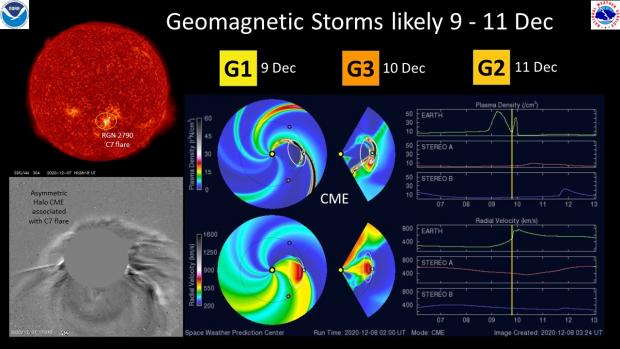
The National Weather Service’s Space Weather Prediction Center (SWPC) has issued a Geomagnetic Storm Watch for Earth which starts today and extends through Friday, with tomorrow being the peak day for potential problems. Because of the strength of inbound energy, a G3 Watch is in effect for Thursday which indicates a “strong” event is possible.
A coronal mass ejection, also known as “CME” for short, is responsible for this Watch. A coronal mass ejection is a significant release of plasma from the solar corona, often following solar flares in solar wind. These huge explosions of plasma originate from highly twisted magnetic field structures on the Sun. When these explosions occur from active sunspot regions on the Sun, it is not uncommon to see them associated with large solar flares. Some fast CMEs can reach the Earth in little as 14 hours, while others may take several days. According to the SWPC, “the first sign of a CME hitting the Earth environment is the plasma density jump due to the shock wave’s passage.” Forecasters use what is known as a coronagraph, which blocks the extremely bright disk of the Sun, so they are able to determine the CME’s size, speed, direction and density.
According to the SWPC, a significant CME occurred on December 7th and was associated with a C7 flare from Region 2790. Analysis suggests CME arrival possible later today, initially resulting in G1 (Minor) storm levels. As the CME effects continue, activity is likely to increase, especially if the magnetic field carried with the CME connects well with Earth’s magnetosphere. Therefore, the potential for strong storm levels exists and a G3 (Strong) Watch is in effect for December 10th. CME-related disturbances are forecast to continue into 11 December, likely resulting in G2 (Moderate) storm levels – and another Watch has been issued accordingly. While SWPC forecasters are fairly confident in CME arrival at Earth, timing and geomagnetic storm intensity are less certain.
The SWPC says this geomagnetic storm could impact electrical systems, trigger alarms, harm spacecraft, impact navigation systems, and interfere with radio signals. A geomagnetic storm like this can also produce a vibrant aurora at northern latitudes, with some aurora possible in skies as low as Washington, Idaho, Nebraska, Illinois, Indiana, Ohio, Pennsylvania, and New Jersey.
While typically known for their weather forecasts, the National Oceanic and Atmospheric Administration (NOAA) and its National Weather Service (NWS) is also responsible for “space weather.” While there are private companies and other agencies that monitor and forecast space weather, the official source for alerts and warnings of the space environment is the Space Weather Prediction Center (SWPC). The SWPC is located in Boulder, Colorado and is a service center of the NWS, which is part of NOAA. The Space Weather Prediction Center is also one of nine National Centers for Environmental Prediction (NCEP) as they monitor current space weather activity 24/7, 365 days a year.
Experts have indicated that we are entering an active solar cycle now and incidents like this will increase with frequency and intensity in the coming months.